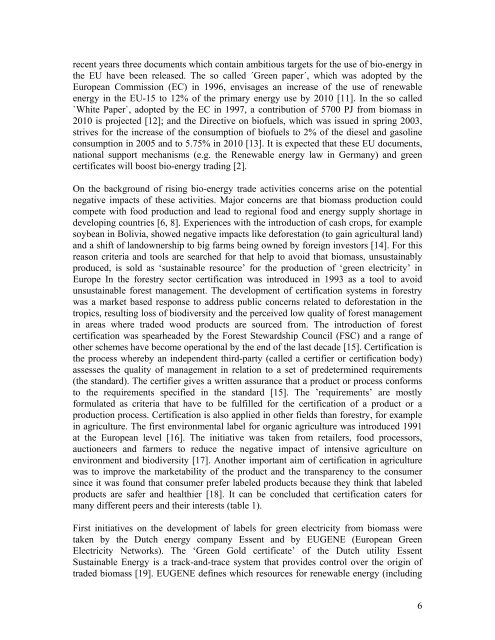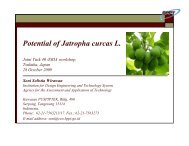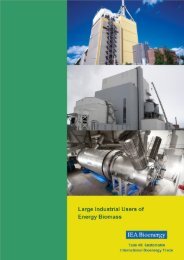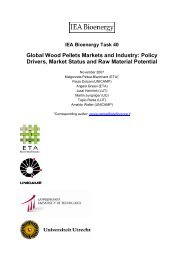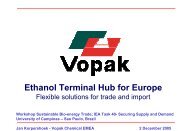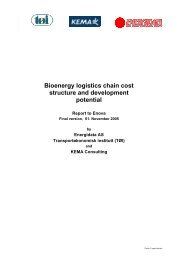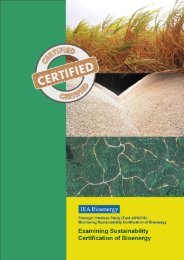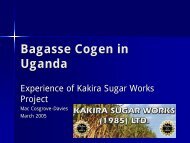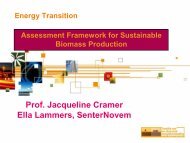steps towards the development of a certification system for ...
steps towards the development of a certification system for ...
steps towards the development of a certification system for ...
Create successful ePaper yourself
Turn your PDF publications into a flip-book with our unique Google optimized e-Paper software.
ecent years three documents which contain ambitious targets <strong>for</strong> <strong>the</strong> use <strong>of</strong> bio-energy in<strong>the</strong> EU have been released. The so called ´Green paper´, which was adopted by <strong>the</strong>European Commission (EC) in 1996, envisages an increase <strong>of</strong> <strong>the</strong> use <strong>of</strong> renewableenergy in <strong>the</strong> EU-15 to 12% <strong>of</strong> <strong>the</strong> primary energy use by 2010 [11]. In <strong>the</strong> so called`White Paper`, adopted by <strong>the</strong> EC in 1997, a contribution <strong>of</strong> 5700 PJ from biomass in2010 is projected [12]; and <strong>the</strong> Directive on bi<strong>of</strong>uels, which was issued in spring 2003,strives <strong>for</strong> <strong>the</strong> increase <strong>of</strong> <strong>the</strong> consumption <strong>of</strong> bi<strong>of</strong>uels to 2% <strong>of</strong> <strong>the</strong> diesel and gasolineconsumption in 2005 and to 5.75% in 2010 [13]. It is expected that <strong>the</strong>se EU documents,national support mechanisms (e.g. <strong>the</strong> Renewable energy law in Germany) and greencertificates will boost bio-energy trading [2].On <strong>the</strong> background <strong>of</strong> rising bio-energy trade activities concerns arise on <strong>the</strong> potentialnegative impacts <strong>of</strong> <strong>the</strong>se activities. Major concerns are that biomass production couldcompete with food production and lead to regional food and energy supply shortage indeveloping countries [6, 8]. Experiences with <strong>the</strong> introduction <strong>of</strong> cash crops, <strong>for</strong> examplesoybean in Bolivia, showed negative impacts like de<strong>for</strong>estation (to gain agricultural land)and a shift <strong>of</strong> landownership to big farms being owned by <strong>for</strong>eign investors [14]. For thisreason criteria and tools are searched <strong>for</strong> that help to avoid that biomass, unsustainablyproduced, is sold as ‘sustainable resource’ <strong>for</strong> <strong>the</strong> production <strong>of</strong> ‘green electricity’ inEurope In <strong>the</strong> <strong>for</strong>estry sector <strong>certification</strong> was introduced in 1993 as a tool to avoidunsustainable <strong>for</strong>est management. The <strong>development</strong> <strong>of</strong> <strong>certification</strong> <strong>system</strong>s in <strong>for</strong>estrywas a market based response to address public concerns related to de<strong>for</strong>estation in <strong>the</strong>tropics, resulting loss <strong>of</strong> biodiversity and <strong>the</strong> perceived low quality <strong>of</strong> <strong>for</strong>est managementin areas where traded wood products are sourced from. The introduction <strong>of</strong> <strong>for</strong>est<strong>certification</strong> was spearheaded by <strong>the</strong> Forest Stewardship Council (FSC) and a range <strong>of</strong>o<strong>the</strong>r schemes have become operational by <strong>the</strong> end <strong>of</strong> <strong>the</strong> last decade [15]. Certification is<strong>the</strong> process whereby an independent third-party (called a certifier or <strong>certification</strong> body)assesses <strong>the</strong> quality <strong>of</strong> management in relation to a set <strong>of</strong> predetermined requirements(<strong>the</strong> standard). The certifier gives a written assurance that a product or process con<strong>for</strong>msto <strong>the</strong> requirements specified in <strong>the</strong> standard [15]. The ’requirements’ are mostly<strong>for</strong>mulated as criteria that have to be fulfilled <strong>for</strong> <strong>the</strong> <strong>certification</strong> <strong>of</strong> a product or aproduction process. Certification is also applied in o<strong>the</strong>r fields than <strong>for</strong>estry, <strong>for</strong> examplein agriculture. The first environmental label <strong>for</strong> organic agriculture was introduced 1991at <strong>the</strong> European level [16]. The initiative was taken from retailers, food processors,auctioneers and farmers to reduce <strong>the</strong> negative impact <strong>of</strong> intensive agriculture onenvironment and biodiversity [17]. Ano<strong>the</strong>r important aim <strong>of</strong> <strong>certification</strong> in agriculturewas to improve <strong>the</strong> marketability <strong>of</strong> <strong>the</strong> product and <strong>the</strong> transparency to <strong>the</strong> consumersince it was found that consumer prefer labeled products because <strong>the</strong>y think that labeledproducts are safer and healthier [18]. It can be concluded that <strong>certification</strong> caters <strong>for</strong>many different peers and <strong>the</strong>ir interests (table 1).First initiatives on <strong>the</strong> <strong>development</strong> <strong>of</strong> labels <strong>for</strong> green electricity from biomass weretaken by <strong>the</strong> Dutch energy company Essent and by EUGENE (European GreenElectricity Networks). The ‘Green Gold certificate’ <strong>of</strong> <strong>the</strong> Dutch utility EssentSustainable Energy is a track-and-trace <strong>system</strong> that provides control over <strong>the</strong> origin <strong>of</strong>traded biomass [19]. EUGENE defines which resources <strong>for</strong> renewable energy (including6


